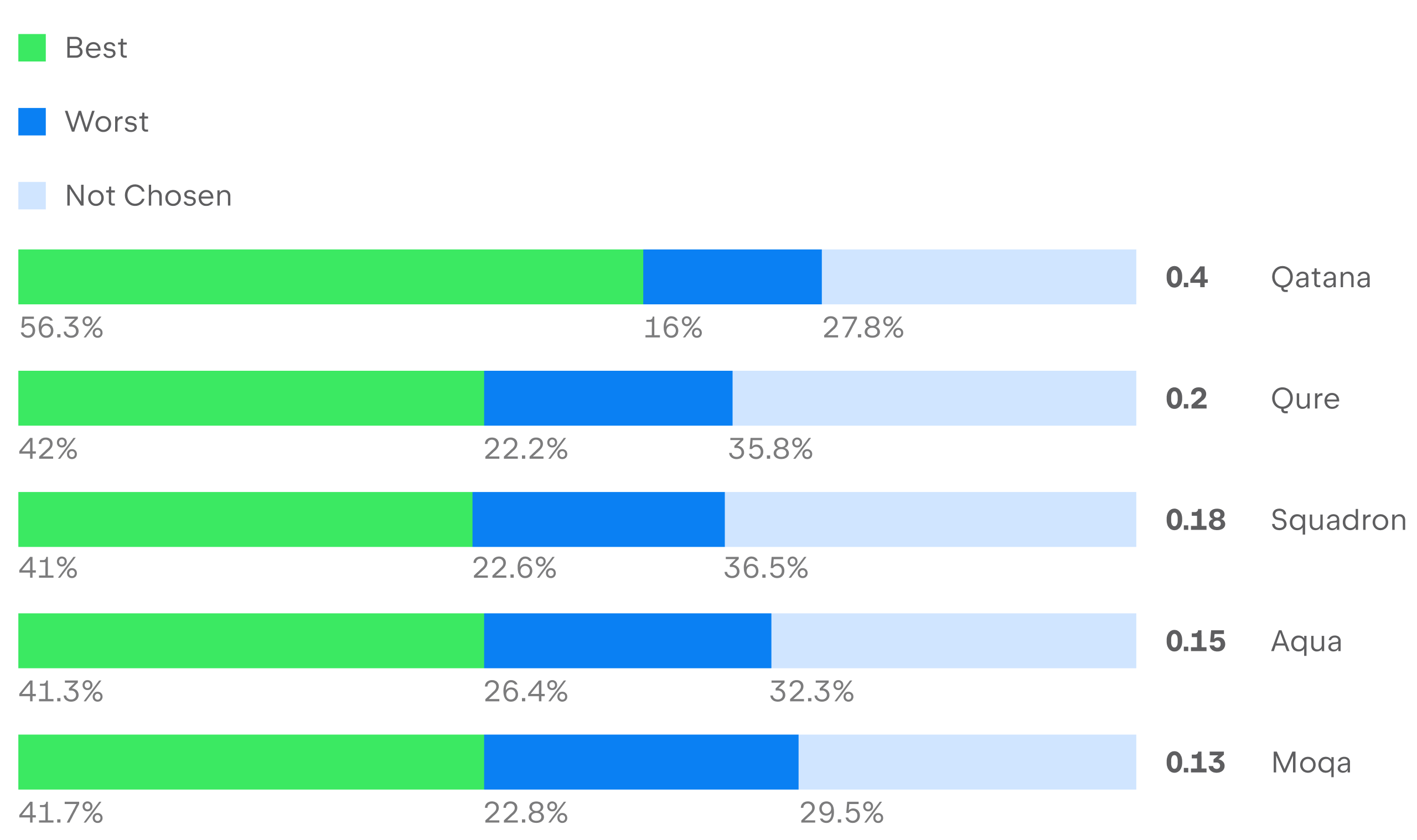JetBrains Research
Research is crucial for progress and innovation, which is why at JetBrains we are passionate about both scientific and market research
Crafting the Perfect Name: The Story of JetBrains Aqua
The Market Research & Analytics team at JetBrains formed more than 10 years ago as a group of marketing analysts and eventually transformed into the company’s Research Hub, which conducts research and helps other teams develop research competency. You may already be familiar with our work from the Developer Ecosystem Survey, but this is far from our only area of research interest. This post is the first in a series focusing on our team, the kind of research we do, and how it drives product development.

As a part of the Research department at JetBrains, the Market Research & Analytics Team works in a variety of capacities related to studying the ecosystem of software developers. Our goal is to provide trusted, objective, and comprehensive research results that enable data-informed decision-making across the company. With extensive experience and expertise in data analysis, surveys, UX research, cognitive studies, and business research, our team is well-equipped to address all sorts of challenging questions.
The research we’ve done for JetBrains products has yielded a lot of interesting findings and stories that we’d like to share with you. We’ve decided to start this blog to share our perspective on how research can benefit product development. Whether you’re a developer seeking to understand the latest trends, a product manager in need of data-driven decision-making support, or a member of a business team interested in gaining insights into user behavior, you will find valuable and interesting information about the software developer community here. Our posts will give you insights into the industry and a glimpse into our research process, including the data we collect and the methodologies we employ.We hope these stories about the work we do pique your interest and inspire you to participate in qualitative and quantitative research. Your engagement will help us provide more accurate insights about the community in our public reports and improve JetBrains products. Join our JetBrains Tech Insights Lab to take part in our future studies.
In this first post of the series, we’ll dive into the topic of naming research, showcasing our workflow and explaining how we contribute to the names of JetBrains products. The contribution our team makes to this process is crucial, as a name can make or break a product. Choosing a good name involves a creative process, but that creativity must be harnessed through research methods to ensure the final result speaks to the target audience. To give you more concrete insight into our naming workflow, and the role our users play in it, we’ll look at the research we did for JetBrains Aqua – an integrated development environment (IDE) tailored for test automation.
Our naming workflow
Naming a product involves more than just picking something that sounds cool or catchy. There’s a complex process involved that requires contributions from many teams throughout the company. Before we can settle on the final name for a product, we first have to conduct interviews with product team members, brainstorming sessions, uniqueness checks, linguistic evaluations, surveys of the target audience, and analysis of potential legal and trademark issues, all leading up to the decision making and approval stage.
Step 0: Clarifying the vision
In the preliminary research stage, the naming researchers dive into the context of the product by interviewing the stakeholders from the product team. This allows them to understand the current state of the product’s development and embrace the team’s vision for it.
Step 1: Structuring creativity
A facilitated brainstorming session serves as the first step in the naming research process, helping the team structure their discussions and enhance creativity by establishing a framework and some rules. At this stage, the product’s creators share their personal associations with the product and related values. The team further discusses how they’d like to present their creation to users, and ultimately they come up with 50–70 unique name suggestions.
Step 2: Clearing the field
With the results of the brainstorm in hand, the next step involves narrowing our options by considering which ones are actually available. Through extensive research with search engines and patent databases, our team ensures that the potential names don’t overlap with any existing IT companies or products. Many options fail this check, leaving us with a list of 20–30 names.
Step 3: Linguistic analysis
To ensure that our final choice will be appropriate wherever the product will get the most use, native speakers of English, German, Chinese, French, and other languages evaluate the potential names. This linguistic check further narrows down the options, leaving as few finalists as possible. At this stage, our experts take into account a wide variety of criteria, from negative connotations in different languages to ease of pronunciation. Even if the word itself doesn’t mean something negative, it could still be associated with something bad, and we don’t always see these connections during the brainstorming phase. For this, the expertise of native speakers is very important to us.
Step 4: The audience’s verdict
In order to understand the preferences of potential users, our naming researchers conduct a thorough survey of over 300 individuals. The survey identifies the most and least popular names, leaving us with three strong contenders.
Step 5: The legal check
When naming a product, it’s essential to make sure the name won’t create any legal problems. With the help of legal experts and trademark searches, our naming research team ensures that all of our potential names are in the clear. Any questionable or risky options are weeded out at this stage, leaving only ones that are safe to use.
The final step: Choosing the perfect name
Though the list of candidates at this point is rather small, this series of rigorous checks has left the product team with a lot of information to consider. After reviewing the various collections of feedback, they make their final choice and pick the name that fits their goal the best.
From Qatana to Aqua
So, why did we choose the name “Aqua” for an IDE with a focus on test automation? Throughout the brainstorming phase, the name Aqua became closely linked among the product team with cleanliness and uninterrupted flow, making it an ideal fit for a quality assurance product. Furthermore, the term “Aqua” serves as an acronym for “automation quality assurance”, further reinforcing its suitability. Although its somewhat generic meaning made it seem like a risky choice, the linguistic check yielded many positive reviews from native speakers.
The turning point was when we conducted an external user survey on X (ex-Twitter). Before the survey, the Aqua option was not a priority and might not have been included in the shortlist. However, the survey respondents ranked Aqua fourth out of 18 options with 41.3% positive feedback received. The positive assessment of the respondents made the team pay more attention to this option.

The Qatana option received the most positive reviews and could have become a new name for the IDE. However, the team decided against this option because it didn’t capture the product’s core essence, and any similarity to Qodana wasn’t seen as a benefit. So, the Aqua option shone brightly. After confirmation from lawyers that the name was safe to use, the product team ultimately chose this name for the product.
It is important to highlight that the success of a naming project depends on the active engagement of the stakeholder team, as they possess in-depth knowledge about the product and truly comprehend its essence. The Aqua team played an active role in generating names during the brainstorming phase and made careful decisions at each stage.
Although Aqua wasn’t initially a top choice, feedback from users like you pushed them to reconsider, and it turned out to be the perfect fit. Numerous positive reviews from users indicated that the name communicates the product team’s vision, signaling that our naming approach was a success. In this case, JetBrains users were integral to the process and had a great impact on the product’s name and brand. If this is the kind of impact you’d like to have on future products, be sure to sign up for our JetBrains Tech Insights Lab!
Naming research is a creative and engaging process that requires the collaboration of many teams. In order to channel that creativity and ensure that we don’t skip any important checks or problematic details, we adhere to an established research-based workflow. We hope that this workflow will prove useful for product teams and researchers who want to come up with names for products in the future.
You can download the latest version of JetBrains Aqua from our website, and you can update it to the latest version directly from the IDE or via the free Toolbox App. Please use this form to share your feedback or ask any questions you might have.
To receive news about the latest improvements to the IDE, subscribe to the JetBrains Aqua blog and follow JetBrains Aqua on X!
Subscribe to JetBrains Research blog updates





